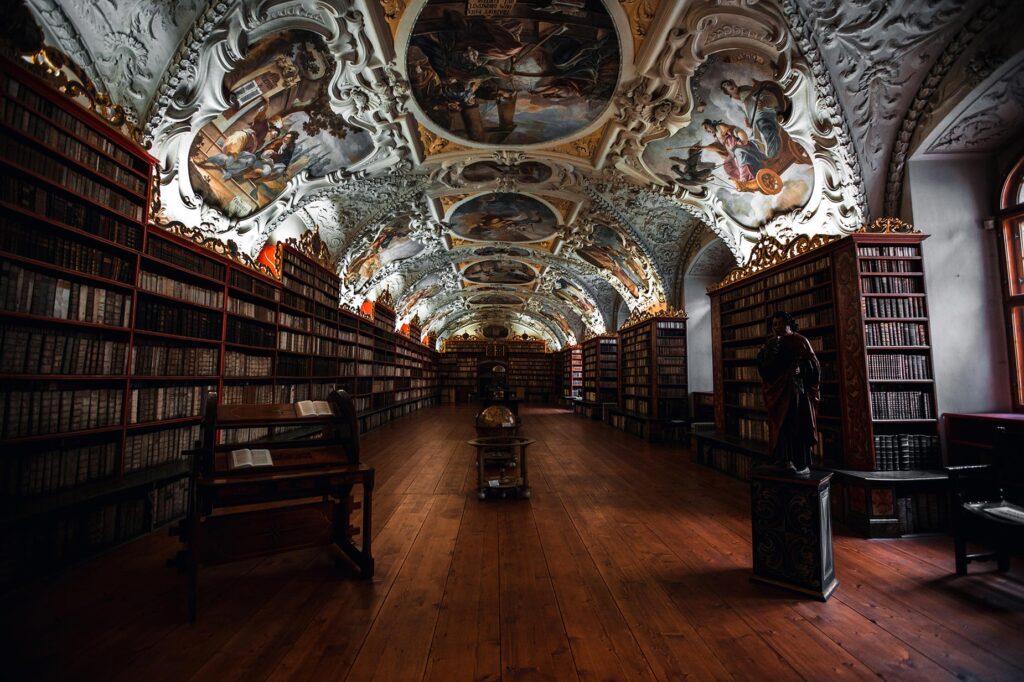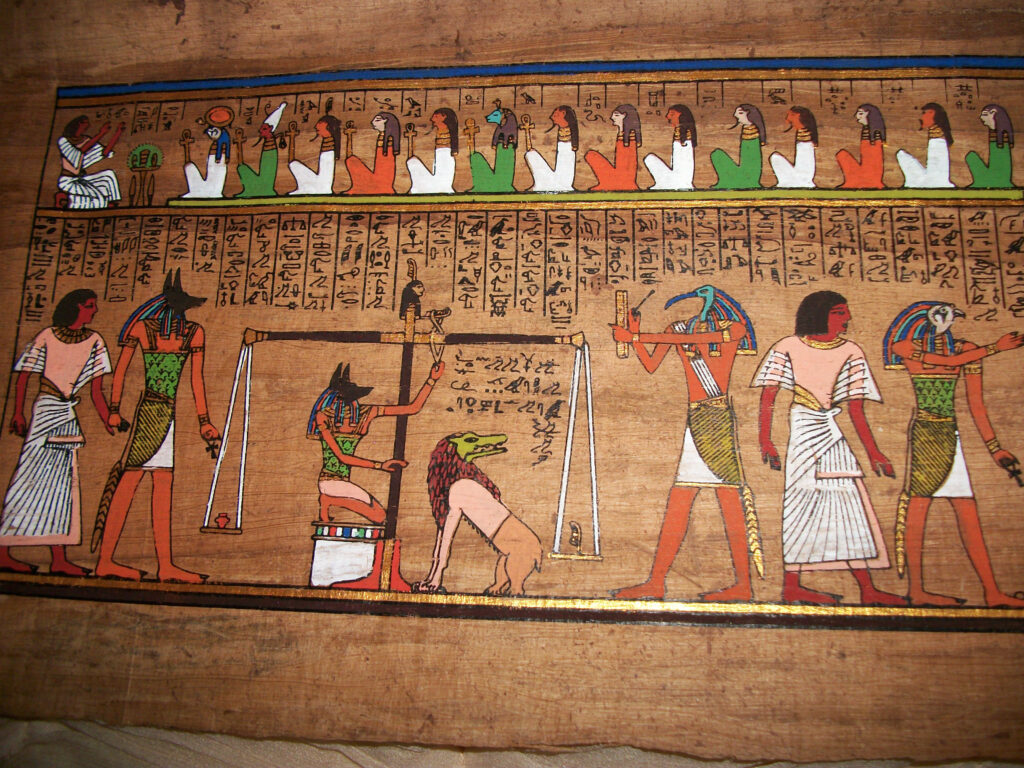The History of the Future
Nostradamus: How Did He Do It?
Tool 3: Ancient Hidden Astrology Books

by Larry A. Filoso, February – September 2023, revised May 2024
As this article began, we learned one Tool that Nostradamus used to predict future events: his considerable psychic ability. Authorities down through history have consulted psychics to help them to solve their most difficult problems and to help them to plan for the future.
In Tool 2, we read how an earlier astrologer predicted that Nostradamus would be born, and how a Renaissance scholar searched for him based on that prediction. From an early age he learned astrology, his second tool. We read some of his words describing how he used the celestial science.
He was born on a grand conjunction of Saturn, Jupiter and Mars. If we were looking up into the night sky when he was born, these three very bright “stars” (actually, planets) would be very close to one another. Astrologers call this a “conjunction”. This happens about every 20 to 40 years. Now, let’s look at the third tool…
Ancient Hidden Astrology Books
Nostradamus wrote that he had studied books which had been hidden for a very long time: ”…how many volumes that have been hidden for long centuries have been provided to me.“ [Leoni pg 125:16]
In 48 BCE Julius Caesar burned the university and library in Alexandria, Egypt, plunging the Western world into the Age of Pisces. Egyptian-Greco-Roman science and technology were temporarily “thrown into the shadows” in the West during the “Dark Ages”.
The Saturn/Jupiter conjunction of 66 BCE had been in Pisces.
But Alexandria wasn’t the first great storehouse of knowledge in Egypt. Millennia before Caesar conquered Egypt, the original Egyptians had another great library and university according to the famous Greek, Plato.
In his book “Timaeus”, written around 360 BCE, Plato mentioned an Egyptian city which, even in his time, was very ancient. [23] The pre-dynastic city of Sais [24] had a temple, medical university and an extensive library containing writings which had existed as far back as 8,000 years before Alexandria. [25]
What Plato was revealing had been passed-down to him from one of his family ancestors, Solon, who had travelled from Greece to Egypt around 590 BCE. According to Plutarch, Solon met with several priests at Sais, including one named Sonchis. At the library there Solon studied thousands of years of history calibrated by astrology, including details about the Precession of the Ages.
It was from some of this passed-down knowledge that Plato wrote in “Timaeus”, over 1800 years before Christopher Columbus, that the Earth and the other planets were round spheres (not flat). Columbus had the courage to make his trip to the Americas because he had read Plato and other Hidden Books.
In “Timaeus” Plato also wrote about long cycles of time after which an apocalypse occurs and human civilization experiences a “reboot”. He wrote that this has happened over and over again, perhaps for hundreds of thousands of years. He called it the “Great Year”, which currently lasts about 27,000 normal years. Today we call this long cycle of time “Precession of the Ages” or “Precession of the Equinoxes”.
Copies of Plato’s writings and much more knowledge went up in smoke as Caesar conquered Egypt. But darkness doesn’t last forever.
The pattern of Saturn/Jupiter grand conjunctions repeats at the same location in the zodiac every 800 years. And so it was that eight centuries after the Roman Julius Caesar, a new administration took over in Egypt…
The Abbasids conquered Egypt around 750 AD (CE) and set about learning as much as possible from the Egyptians. Knowledge was not just stored in libraries there – it was all over the walls of temples and buildings, written in Hieroglyphics.
The wise man Dhul-Nun al-Misri, born in Upper Egypt in 796 AD (CE), translated ancient Egyptian Hieroglyphics and revealed the vast knowledge they recorded. [26] In 820 AD, based on their study of Egyptian texts, the Abbasids discovered and opened the hidden main entrance to the Great Pyramid.
Treasure-hunters had searched for that entryway for 3,000 years. It is still used by tourists today.
Professor Okasha El Daly, Egyptologist and Honorary Senior Research Fellow at the University Center London, has shown that around 900 AD ibn Wahshiyya printed a table showing the translation of selected Hieroglyphs into Arabic, probably copied from Dhul-Nun’s lost or hidden earlier work. [27]
The Abbasids built universities and libraries in Cordoba, Spain; Timbuktu, North Africa; and in their capital Baghdad, Iraq. These “Houses of Wisdom” reproduced the great centers of learning in ancient Egypt.
Jewish, Christian, and Muslim scholars were all welcome, and working together, they contributed to this first Renaissance. They studied and wrote about mechanical engineering, optics, medicine, chemistry, physics and… astrology.
In 762 AD (CE) the Abbasid Caliph al-Mansur hired several astrologers to create an “electional horoscope” to give him the luckiest date and time to begin the building of their capital city of Baghdad. One of those stargazers was the 22-year-old Persian/Jewish Masha Allah ibn Athari.
Masha Allah later wrote manuscripts about the conjunctions of Saturn and Jupiter (when they move close together as viewed in the night sky). He wrote about the changes in religion and politics that those conjunctions foretold. He composed documents about the construction of astrolabes (machines used to locate and predict where the stars and planets would be in the sky on any date), and about many other topics relating to astrology.
Today’s scholars call the Abbasid Renaissance the “Islamic Golden Age”. It lasted about 200 years. Afterwards, in the mid 1100’s, John of Seville, a baptized Jew living in Spain, began to translate some of these astrological works from Arabic into Latin. This laid the groundwork for the start of the European Renaissance almost 800 years after the Abbasid Renaissance began… and Astrology lead the way.
If you are interested in reading translations of some of these and other medieval astrological texts, try this book by James H. Holden: https://www.astrologers.com/product-page?product_id=1052
The Secret Library That Fueled the Renaissance
In the mid 1300’s, a Catholic cleric named Francesco Petracco (“Petrarch”) continued with this trend. He collected ancient hidden Greek and Roman texts and had them translated into the Latin spoken at that time. After he died, most of his documents were sold off to other collectors.
One pattern of Saturn/Jupiter conjunctions began moving into the anchor sign of Scorpio in 1365, the sign of secrets hidden.
By the beginning of the 1400’s, Cosimo de’ Medici, ruler of a capitalist Roman empire centered in the Republic of Florence, wanted to bring ancient knowledge to Europe. He purchased some of the volumes from Francesco’s library and hired Niccolo de Niccoli to organize and catalogue them.
In 1439 a contingent of Greek scholars visited Florence and presented Cosimo with many ancient Greek manuscripts, which he added to his collection. [28] Some, like those from Plato, contained knowledge inherited from ancient Egypt. The Greeks may also have given Medici an ancient computer (see Tool 4 of this article).
About this time the Medici’s began painting representations of their star charts on their buildings and ceilings, as the Egyptian pharaohs had done thousands of years before.
Cosimo acquired manuscripts from all over the world, and hired experts to translate them into Latin. [29] He created a secret international library in Florence.
Cosimo de’ Medici purchased Abbasid manuscripts from Spain and Timbuktu. They likely included the works of Abraham ben Meir Ibn Ezra, Dhul-Nun al-Misri, Masha Allah ibn Athari, ibn Wahshiyya, Abu Ma’shar al-Balkhi, and many others.
The Medici’s also procured ancient manuscripts from wealthy traders along the Silk Road. In the early 1500’s, they likely bought texts about Aztec and Mayan astrology and science, like the Voynich manuscript or the Popol Vuh.

Renaissance luminaries, including Leonardo da Vinci, Michelangelo, Botticelli, Raphael, Machiavelli, Brunelleschi, Galileo, Luca Gaurico (the Medici’s astrologer), Julius-Caesar Scaliger and Nostradamus, all benefited from the Medici’s patronage and their covert library of ancient knowledge of art and science.
Nostradamus traveled to Italy, and “checked-out” a lot of these books. But it all had to be kept hush-hush …how many volumes that have been hidden for long centuries have been provided to me.
This library fueled the Renaissance, the “Rebirth” of Egyptian-Greco-Roman science, technology, and humanism.
Later, the less controversial Medici volumes were re-located in what is today called the “Laurentian Library”, housed in a building designed by Michelangelo. The remainder of the knowledge and wisdom from this library is hidden or lost to us so far.
Abu His Guru
Going back to the 9th century for a moment… about 850 AD another Abbasid academic, Abu Ma’shar al-Balkhi, wrote many treatises on astrology and astronomy, and made predictions. His work was likely based upon ancient Egyptian knowledge, perhaps from their Hieroglyphic writings.
Another of his sources may have been the ancient astrological teachings of Zoroaster and his astrologer Vishtaspa, who lived around 1500 BCE. They wrote down prophecies of the future based upon “signs in the heavens”. One “sign” which is used by many astrologers is the conjunction of the planets Saturn and Jupiter, which happens about every 20 years. A conjunction occurs when planets, looking like bright stars, appear very close together in the night sky.
Abu Ma’shar’s writing influenced most astrologers of the Renaissance period. His works were very likely found in the Medici secret library.

In Abu Ma’shar’s manuscript, “De magnis coniunctionibus” (Of Grand Conjunctions), he wrote that the long-term patterns of Saturn and Jupiter conjunctions, with Mars, could be used to predict the rise and fall of empires and religions. They could also portend natural disasters, and unusual celestial events such as comets and supernovae, all within the framework of the Precession of the Ages. [31]
This text listed the conjunctions in his future, and what events each symbolized. He predicted that around 1484 AD (600 years after his time) a “little prophet” would be born. This would not be a “big Prophet” like Moses or Mohammed.
You might remember from Tool 2 of this article that the astrologer Paul of Middelburg believed that this prophet would be born in 1503, rather than 1484.
Paul added one Metonic eclipse cycle to Abu Ma’shar’s date (1484 + 19 years = 1503). Also, in 1503, Mars was conjunct Saturn and Jupiter.
In fact, 1503 was the year in which Nostradamus was born. Abu Ma’shar was one of Michel de Nostredame’s main references. I like to think of Abu Ma’shar as one of his astrological gurus. The methods and dating that Nostradamus used are similar to Abu Ma’shar’s.
For example, compare what Nostradamus wrote with “Of Grand Conjunctions” (above):
All these figures are justly adapted, by the divine writings, to the visible celestial objects, that is to say, by [conjunctions of] Saturn, Jupiter and Mars and the other consorts [planets], as one will be able to see more fully in some quatrains. [Leoni pg 345:57]
Nostradamus himself was born during just such a grand conjunction of Saturn, Jupiter and Mars. In his 4th house in the sign of Cancer, was found Jupiter at 11°, Saturn at 15° and Mars at 19°, all in retrograde.
Another major influence on Nostradamus was the writings of his fellow Christian Frenchman, Cardinal Pierre d’Ailly (1351-1420, pronounced: die-ee’), who was highly respected within the Catholic Church. At first he criticized astrology as superstition. After extensive study, however, he became an expert astrologer and a proponent.
Like Nostradamus, Pierre read Abu Ma’shar and became an adept in the conjunctions of Saturn/Jupiter. He used them to try to date and predict the events foretold in the books of Daniel and Revelations in the Bible. Pierre lived 150 years before Michel de Nostredame.

All of these astrologers traced their lineage back to ancient Egypt. Most of them left hints of this by studying and writing about Hieroglyphics.
Nostradamus might have been able to read some ancient texts written in Egyptian Hieroglyphics three hundred years before today’s scholars believe they were first translated by Champollion.
He wrote, ”And from the building of the Temple until Jesus Christ, according to the calculation in the Hieroglyphs, passed four hundred and ninety years.“ [Leoni, pg 338:40] In order to hide the word “Hieroglyphs”, he changed the letters “ly” to “ra” and wrote “Hierographs”.
In the early 1550’s Nostradamus wrote and published (for limited distribution) what might have been a translation of a book about Egyptian Hieroglyphics. It was titled “Orus Apollo, Son of Osiris, King of the Nile Egypt, with Hieroglyphic Notes”. [32] [Leoni, pg 89] I believe it was written in secret code as part of a secret society to which he belonged.
John Dee, astrologer to Queen Elizabeth I, also wrote a book in 1608 titled “Monas Hieroglyphica” (“The Hieroglyphic Monad”). [33]
In 2018 a large book was discovered, which had been hidden away in the Fesch library in Corsica, France. Titled “Thesaurum Hyeroglyphicorum” (The Thesaurus of Hieroglyphics), it was written in Latin and dated 1610.
Summary
The Renaissance in Western Civilization occurred in Europe from about 1400 through 1600 CE (AD). This was a “Rebirth” of knowledge which traces its roots back to ancient Egypt. The ancient Greeks were one link in this chain.
Proof is just now beginning to emerge that Abbasid scholars, in the 8th and 9th centuries, began to translate the two main Egyptian written languages. Hieroglyphic was carved and painted on the walls and ceilings of temples and tombs, while Hieratic was written in ink onto papyrus scrolls.
These words opened the hidden doorways to science, technology, history and humanism. Astrology, and since that discipline studies Time, history, were the first to be reborn. As the luminaries of the Renaissance, including Nostradamus, rediscovered this wisdom they left a trail so that we would know their source.
In the next part of Ancient Hidden Astrology Books, I share how some Renaissance astrologers became astronomers when “bearded stars” appeared in the Heavens, as predicted in Abu Ma’shar’s ancient astrology books.
Nostradamus wrote that these stars would serve as omens to coincide with the end of the Renaissance and great changes in the religion and politics of Europe.
Next time, in The History of the Future, Nostradamus: How Did He Do It?
References, Citations and Notes
All charts and planetary positions were calculated using Solar Fire version 9 in Windows.
For citations from Edgar Leoni’s book, one of my main references, I specify the Century and Quatrain numbers for poems, or Page:Paragraph numbers for prose writings. Within my text, direct quotations from Nostradamus are printed in Red, usually with the citation source next to the quotation for easy reference.
Nostradamus: How Did He Do It? Tool 3 was published in the American Federation of Astrologers magazine “Today’s Astrologer” in the March 10, 2024 edition, Volume 86, Number 3.
The AFA was founded in 1938 to promote the art and science of astrology through education and research. It was the first American national astrological organization to administer certification examinations to encourage a high standard of professional ethics among astrologers.
